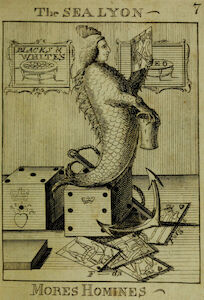Black and White Cocks
Last updated: .
Black and White Cocks — an apparently un-Googleable name — was a gambling game played in England in the 19th century. In 1838 it was described as a “well-known game of chance”,A but it seems to have died out before the 20th century.

The caption from the book reads: “A remarkable Caricatura, compounded of ſeveral ſpecies, being by ſome ſuppoſed to be a Sea-Calf, by others a Sea Lion; after having been toſſed about on his native Element for ſome Years, he was caſt aſhore on a gaming Iſland, where he was ſo captivated with Cards and Dice, that he commenced Gameſter, and fixed upon the Iſland ever ſince.”
The form of the game is still obscure to me, but based upon brief descriptions, it was a gambling game played with a spinning wheel,B probably much like the game E–O (an early form of Roulette). A table with black and white cocks (presumably roosters) painted on it was used, probably as a staking layout,C where bets as low as a penny could be placed.A Like other games of this type, it was played at racecourse meetsD and fairs.E
An earlier depiction of or reference to the game possibly appears in a satirical depiction of John Byng in the book A Political and Satirical History of the Years 1756 and 1757 (p. 36). At top left, opposite the EO table, is “Blacks & Whites”.
In an 1877 catalogue of the British MuseumG (p. 1076) this is interpreted as a reference to the (in)famous White’s gentlemen’s club and gambling house, but it seems to more straightforwardly refer to the game, especially when positioned in a pair with E–O.
References
Anonymous (). ‘Tiverton’. Western Times, : page 3.
Anonymous (). ‘Sharpers At Altcar’. Liverpool Courier and Commercial Advertiser, : page 6.
Anonymous (). ‘Old Bailey’. Morning Chronicle, : page 3. London.
Anonymous (). ‘Eastbourne Hunt Races’. Eastbourne Gazette, : page 4.
Anonymous (). ‘Camberwell Fair’. Star, : page 4. London.
E. Morris (). A Political and Satirical History of the Years 1756 and 1757. E. Morris: London.
Stephens, Frederic (). Catalogue of Prints and Drawings in the British Museum: Division I. Political and Personal Satires volume 3 (part 2): ‘1751 to circa 1760’.